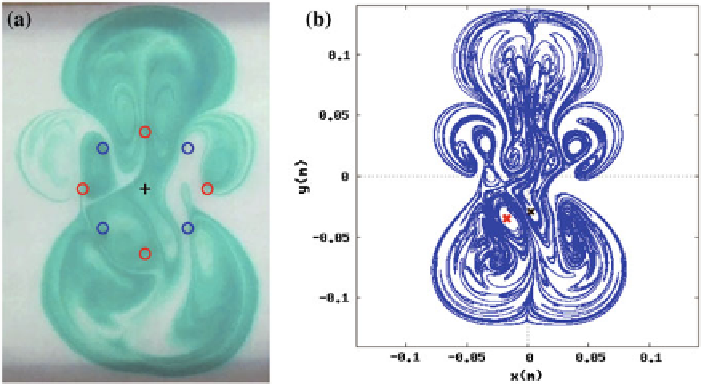Environmental Engineering Reference
In-Depth Information
Fig. 7
Time-dependent flow produced by an array of eight magnets with alternating orientation
at
t
=
143.
a
Experimental visualization.
b
Lagrangian trajectories calculated from the numerical
simulation.
I
=
200mA (
Re
=
212)
lead to symmetry breaking. In general, symmetry breaking can appear due to non-
symmetric magnetic field distribution or non-linear effects. In fact, through experi-
mental flow visualization and animation of the numerical results, we observed that
some vortices in the central flow region rotate counterclockwise and cause vortex
shedding in the
y
-direction.
As in the previous case, the time-dependent behaviour of the flow was explored
by varying the applied current for the arrays of three, four, six, eight and ten magnets.
For each configuration, the current intensity at which the flow transits from steady to
unsteady state was determined. Although aparently unsteady flows show turbulent-
like behaviour (Rossi et al.
2006
) (see, for instance, Fig.
7
), the Reynolds number
is low (
Re
220), thus the unsteady flow patterns remain in the laminar regime.
The applied electric current is not high enough to generate a turbulent flow. Figure
8
shows the stability map that condenses the information of the temporal behavior
of the flows from all the available numerical and experimental results. In the map,
solid black points show the numerically determined value of the current where the
transition from steady to unsteady flow occurs for each array of magnets. Due to
practical reasons, most of the results were obtained from numerical simulations,
however, note that for the available experimental results the numerical prediction
agrees with the experimental observation. From the stability map, it is clear that
increasing the number of magnets in the array, the transition from steady to unsteady
flow occurs at lower intensities of the applied current. Evidently, by increasing the
number of magnets the number of vortices also increases while the distance between
them decreases. This causes stronger interactions of vortices that lead to less stable
configurations prone to develop a time-dependent behavior. In fact, this behavior
favors a better fluid mixing (Figueroa et al.
2014
).
=

Search WWH ::

Custom Search